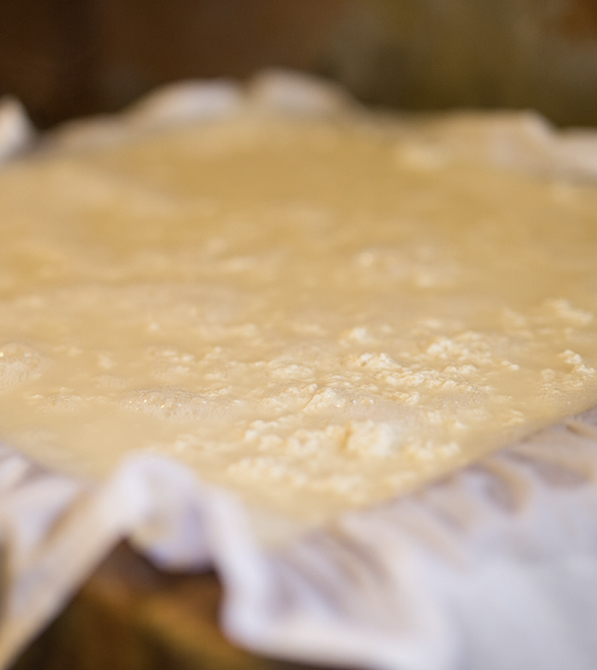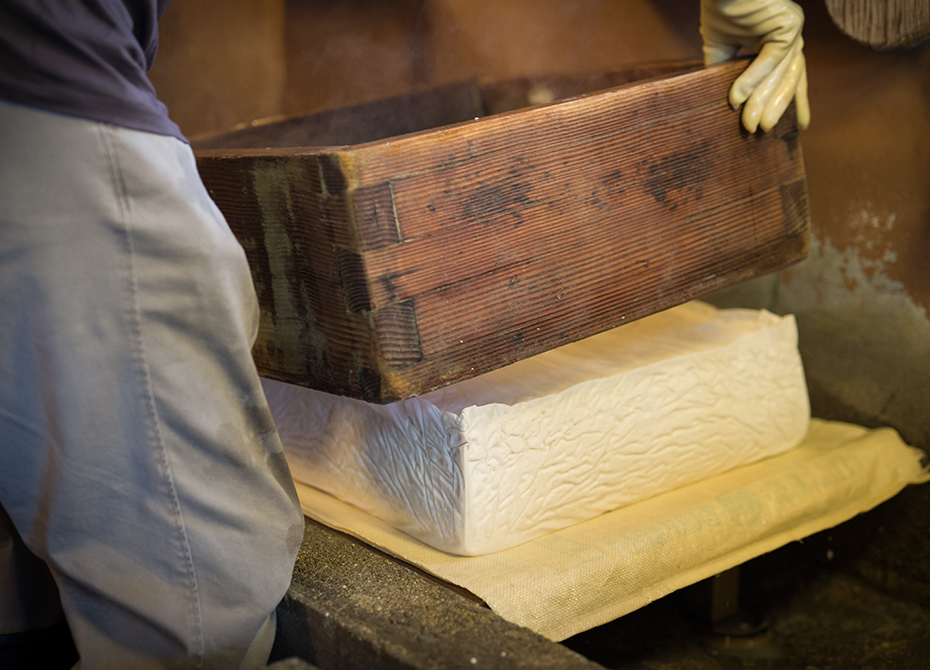
Contents



Gangneung Chodang Dubu







Local Taste · Written by Hwang Gyo-Ik Photographed by Lee Jae-wook
Beans Meet the Sea
Gangneung Chodang Dubu
Dubu (soybean curd) is a popular Asian food known outside of Korea as tofu. Soybeans
originated from Southeast Asia, where people made the dish out of soybeans. In Korea,
every region has its own recipes for making dubu but the beans are generally soaked in
water, ground, cooked in water and then have their soy pulp removed; the remainder is then
solidified with a coagulant. In Chodang Dubu Village in Gangneung, Gangwon-do Province,
seawater is used as coagulant, a practice rarely found elsewhere in the world.

© topicimages
Chodang Dubu Village is near Gyeongpoho Lake in Gangneung, Gangwon-do Province. A legend goes that Heo Yeop, the father of Heo Gyun, the author of the classic Korean tale “The Story of Hong Gil-dong,” used to live in this village. Chodang was also the elder Heo’s pen name. Dating back to the Joseon Dynasty era (1392-1910), the old home of Heo Yeop still stands here, and this is why the origin of Chodang dubu is traced back to him. His revolutionary technique for making dubu using seawater is a tradition that continues today in this village.
Yet the idea that a noble man of Joseon performed such a “chore” remains implausible. The real history of Chodang dubu started with widows who lost their husbands in the Korean War (1950-53) and had to make dubu day and night; they carried their finished products to the now-famous Gangneung Market. This village is also where Korean independence activist and politician Lyuh Woon-hyung (pen name Mongyang) gave night classes at Chodang Institute during the Japanese colonial period (1910-45).
Village residents say just a couple of houses made dubu back in 1951. After the Korean War ended in 1953, however, the number shot up to 90 houses, 57 of which banded together to form Chodang Dubu Co-op. This entity later became Gangneung Chodang Company Inc. due to management difficulties, with a factory in Chodang that supplies the brand Chodang Dubu to grocery stores throughout the country.

Seawater is added as a coagulant in boiled soymilk.
Tradition of Soymilk Coagulation
The recipe for dubu was passed down from China during the Goryeo Dynasty (918 C.E.-1392). Magnesium or calcium is typically used for coagulating from soymilk form to solid dubu, as most dubu factories do today, but seawater and calcium sulfate were used back in the old days.
A cloudy liquid sinks to the bottom when bay salt is left in the air, and this is often called gansu. Rich in magnesium and calcium, gansu is a common ingredient for making dubu. Its coagulation is sometimes said to be the oldest way to make dubu but this seems improbable since bay salt entered Korea during the Japanese colonial era.
Calcium sulfate obtained from mines was probably precious during the Goryeo and Joseon eras, giving rise to the assumption that the seawater method for making dubu was probably more common until the Joseon period. Koreans used concentrated seawater by evaporating water to intensify salt level since the seawater was insufficient for coagulation, with shipping and storage made all the more difficult. Even today, this salty seawater is used as coagulant before being made into solid salt form, which is also called gansu.
Chodang dubu’s biggest distinction from other dubu types is its use of untreated seawater as coagulant. Water from the East Sea nearby Gangneung is so abundant in magnesium and calcium that no concentration process is needed.
All seawater is salty but its composition can differ to a major degree. For example, oceans adjacent to a big river or near glaciers usually have low salt levels, while frequent evaporation in equatorial regions causes higher levels in oceans. The same is true for waters around the Korean Peninsula, with the seas to the west and south showing high salinity. This means bountiful content of magnesium and calcium that can coagulate dubu without concentrating seawater.
Best Eaten for Breakfast
Chodang has nearly 20 dubu locations today. A major change seen in the village during the 1970s was that homes that also sold dubu became restaurants. Many restaurants claim to be original but all share history as dubu restaurants in Chodang, so their histories are not so different other than more commercial dubu restaurants set up by non-locals after the Chodang brand grew popular.
Though their ways of making soymilk and their signature dishes differ, the restaurants have one thing in common: they all coagulate dubu with seawater. Some places stubbornly offer sundubu (white soft dubu) only, while others create a more complete dubu pot with savory sauce.
Morning is the best time to taste authentic Chodang dubu. Beans are ground at 4 a.m. and the cooking of dubu is completed around 7 a.m. The best time to eat dubu is after it is just made. The aroma of fresh beans exuding the briny touch of the sea is the signature of Chodang dubu. Slowly and softly melting in the mouth, Chodang dubu has a compelling and unique taste that attracts numerous visitors to the village year-round.
 Sundubu, before dubu is made, boasts softer texture.
Sundubu, before dubu is made, boasts softer texture.  Dubu is ready when sundubu is kept in a frame and water is squeezed out.
Dubu is ready when sundubu is kept in a frame and water is squeezed out.Mysterious Process of
Turning Beans into Dubu
Making dubu starts at 3 a.m. daily. Grinding beans soaked overnight is the first task and the mechanical millstone is still used here. Workers either separate soymilk and soy pulp right from a millstone or cook them together and strain the soy pulp from the soymilk. The latter is a more traditional way to maximize dubu flavor.
In this village, they cook soymilk in an iron pot. A dubu factory uses a steaming machine. Boiling soymilk requires close attention, as the soymilk must constantly be stirred with a spatula to prevent it from sticking to the bottom. When soymilk boils and creates bubbles, perilla oil is sprinkled so the water doesn’t boil over. Adjusting a stove is also important, as a strong raw bean smell is replaced with an aromatic tasty smell after 30 minutes.
When the soymilk is brought to a boil, the stove is turned off to settle the soymilk. Dubu gets tough when seawater is applied immediately, thus seawater should be carefully added and stirred. Soon after, the solid parts are coagulated into sundubu, pushing the water to the side. The best time for tasting sundubu is 6 a.m. Restaurants in Chodang open early at that time to maximize taste for diners. Sundubu with soy sauce slides down the throat like soup. Dubu is ready when kept in the frame and water is squeezed out. Many visitors also usually come for sundubu.
Surrounded by pine trees, the beautiful Chodang Dubu Village has an especially pleasant smell in the morning. The sea breeze blows close and the wind carries a pine scent throughout the area. There is no better place than this village to eat a bowl of sundubu followed by a breezy walk.

Chodang dubu tastes excellent even with no sauce. © YonhapNews
Other Articles



Gangneung Chodang Dubu












